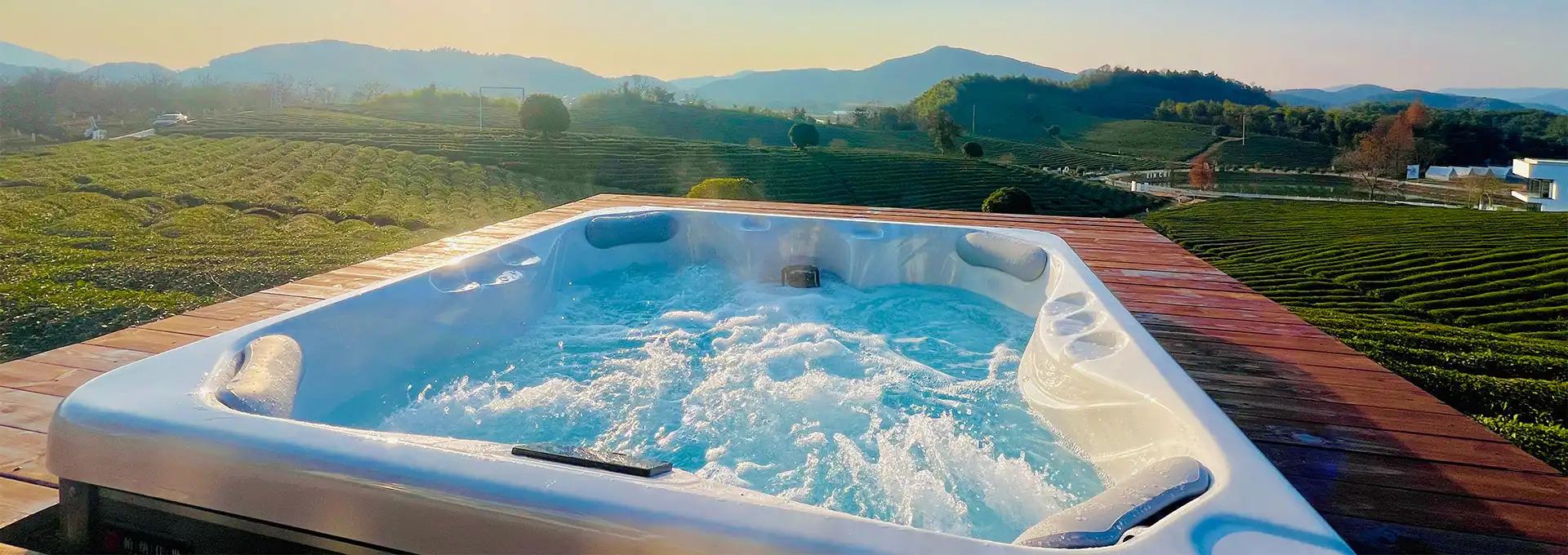How to Install a Swim Spa Electric?
2025-05-12 14:24:39
Installing a swim spa electric system is a crucial step in setting up your personal aquatic oasis. This process requires careful planning, adherence to safety standards, and a good understanding of electrical systems. In this comprehensive guide, we'll walk you through the essential steps and considerations for installing the electrical components of your product, ensuring a safe and efficient setup that will provide you with years of enjoyment.
What are the electrical requirements for a swim spa?
Power supply specifications
When it comes to installing a swim spa electric system, understanding the power supply specifications is crucial. They typically require a dedicated 220-240 volt, 50-60 amp circuit. This high-power requirement is necessary to operate the various components of the product, including the pumps, heaters, and filtration systems. It's important to note that the exact specifications may vary depending on the model and manufacturer of your product. Always consult your product's manual or contact the manufacturer to confirm the specific electrical requirements for your unit. Additionally, it's essential to ensure that your home's electrical system can handle the added load of a product. In some cases, you may need to upgrade your electrical panel or install a sub-panel to accommodate the swim spa's power needs.
GFCI protection requirements
Ground Fault Circuit Interrupter (GFCI) protection is a critical safety feature for any product installation. A GFCI is designed to quickly shut off electrical power in the event of a ground fault, which can occur when electricity escapes its intended path and potentially causes harm. For swim spas, a GFCI breaker is typically required to be installed at the main electrical panel or in a separate sub-panel. The GFCI must be rated to handle the amperage of your swim spa's circuit. It's important to note that the National Electrical Code (NEC) and local building codes often have specific requirements for GFCI protection in product installations. These requirements may include the type of GFCI device to be used, its location, and how it should be wired. Always consult with a licensed electrician familiar with local codes to ensure your swim spa's GFCI protection meets all necessary safety standards.
Wiring and conduit specifications
The wiring and conduit specifications for a swim spa electric installation are critical components that ensure safe and efficient operation. Typically, swim spas require copper wiring due to its excellent conductivity and durability. The gauge of the wire will depend on the amperage of your swim spa and the distance from the electrical panel to the spa location. For most residential product installations, 6 gauge copper wire is commonly used for a 50 amp circuit. However, if the distance is considerable, a larger gauge wire may be necessary to prevent voltage drop. As for the conduit, it's essential to use a waterproof and UV-resistant material, such as PVC or metal conduit, to protect the wiring from the elements. The conduit should be buried at least 18 inches deep, or as specified by local codes, and should include a separate ground wire. It's crucial to ensure that all connections are watertight and that the conduit is properly sealed at both ends to prevent water ingress.
How do you prepare the site for a swim spa electrical installation?
Site survey and planning
Before beginning the electrical installation for your product, a thorough site survey and planning process is essential. This involves assessing the proposed location for your swim spa and determining the best route for the electrical conduit. Consider factors such as the distance from your home's electrical panel, any obstacles in the path (such as trees, other structures, or underground utilities), and the terrain. It's crucial to locate underground utilities before any digging begins - contact your local utility companies or a service like "Call Before You Dig" to have them mark the locations of buried lines. During the planning phase, consider the placement of the swim spa's control panel and ensure it will be easily accessible for maintenance. Also, take into account any local zoning laws or homeowners' association rules that might affect the placement of your product or its electrical components.
Obtaining necessary permits
Obtaining the necessary permits is a critical step in the swim spa electrical installation process. Most jurisdictions require permits for this type of work due to the high voltage involved and the potential safety risks. Start by contacting your local building department to inquire about the specific permits needed for a swim spa installation. You may need both electrical and building permits. When applying for permits, you'll likely need to provide detailed plans of your installation, including the swim spa's location, electrical specifications, and wiring diagrams. Some areas may also require a site inspection before issuing permits. Keep in mind that working without the proper permits can result in fines, mandatory removal of the installation, or complications with your homeowner's insurance. While the permit process might seem like an extra hassle, it's designed to ensure your swim spa is installed safely and meets all local building codes.
Preparing the electrical panel
Preparing your home's electrical panel for a product installation is a crucial step that often requires professional expertise. First, assess whether your current electrical panel has the capacity to handle the additional load of a swim spa. Most products require a dedicated 50-60 amp, 220-240 volt circuit. If your panel doesn't have available space or capacity, you may need to upgrade to a larger panel or install a sub-panel. When adding the new circuit for the swim spa, it's essential to use a GFCI breaker of the appropriate size. This breaker should be installed by a licensed electrician who can ensure it's properly connected and balanced within your panel. The electrician will also need to ensure that the panel is properly grounded and that all connections are secure. If a sub-panel is required, it should be installed close to the swim spa location but still easily accessible for maintenance. Remember, working with high-voltage electrical systems can be dangerous, so it's always best to leave this part of the installation to professionals.
What are the steps to install the electrical components of a swim spa?
Trenching and conduit installation
The process of trenching and conduit installation is a crucial step in setting up the electrical system for your swim spa. Begin by marking the path from your electrical panel to the product location, ensuring it avoids any underground utilities. The trench should be at least 18 inches deep, or as required by local codes, to protect the conduit from damage. Use a trenching tool or hire a professional to dig the trench along the marked path. Once the trench is prepared, lay the conduit in it. The conduit should be rated for underground use and sized appropriately for the wires it will contain. Make sure to include sweep elbows at any turns to make wire pulling easier. It's also important to install an expansion joint where the conduit enters the product cabinet to allow for any ground movement. After laying the conduit, cover it with a few inches of sand to protect it from rocks, then fill the trench with soil, tamping it down to prevent settling.
Wiring and connection
The wiring and connection phase of installing a swim spa's electrical system requires precision and adherence to safety standards. Start by pulling the appropriate gauge wire through the conduit from the electrical panel to the swim spa location. It's crucial to use wire rated for wet locations and sized correctly for the amperage of your swim spa. Typically, this involves running two hot wires, a neutral wire, and a ground wire. At the product end, leave enough wire to reach the control box comfortably. When connecting the wires to the swim spa's control box, follow the manufacturer's instructions carefully. Each wire should be securely connected to its corresponding terminal, with the ground wire properly attached to the grounding lug. Use water-tight connectors where the wires enter the control box to prevent moisture ingress. At the panel end, connect the wires to the GFCI breaker as per the manufacturer's guidelines and local electrical codes. Remember, all connections should be tight and secure to prevent overheating or power loss.
Testing and commissioning
The final stage of installing a swim spa's electrical system involves thorough testing and commissioning to ensure everything is functioning correctly and safely. Begin by turning on the power at the main panel and checking that the GFCI breaker is working properly. Test the GFCI by pressing the test button - it should trip immediately. Reset the breaker and proceed to power up the swim spa. Check all the spa's functions, including pumps, heaters, lights, and any additional features. Pay attention to any unusual noises, vibrations, or smells that could indicate a problem. Use a multimeter to verify that the voltage at the spa's control box matches the required specifications. It's also important to check for any leaks around electrical connections or components. Once you're satisfied that everything is working correctly, run the spa through a complete heating and filtration cycle. This will help identify any issues that might only appear during extended operation. Finally, if your local jurisdiction requires it, schedule an inspection with the building department to get final approval on your installation.
Conclusion
Installing the electrical components of a swim spa is a complex process that requires careful planning, adherence to safety standards, and a good understanding of electrical systems. From assessing power requirements and obtaining necessary permits to trenching, wiring, and final testing, each step is crucial for ensuring a safe and efficient installation. While some aspects of the installation can be DIY, it's highly recommended to involve licensed professionals, especially for the electrical work. By following the guidelines outlined in this article and consulting with experts, you can ensure that your swim spa is installed correctly, providing you with years of safe and enjoyable use. For more information on hot tub installations and our products, please feel free to contact us at info@iparnassus.com.
References
- National Electrical Code (NEC) Handbook, 2020 Edition
- Smith, J. (2019). "The Complete Guide to Swim Spa Installation," Aqua Magazine
- Johnson, R. (2021). "Electrical Safety for Outdoor Spas and Hot Tubs," Electrical Contractor Magazine
- Brown, T. (2020). "Swim Spa Electrical Requirements: A Comprehensive Guide," Pool & Spa News
- Davis, M. (2018). "GFCI Protection for Pools and Spas," EC&M Magazine
- Wilson, L. (2022). "Site Preparation for Swim Spa Installation," Spa & Pool Industry Journal
Send Inquiry
Related Industry Knowledge
- Can a Swim Spa Be In-Ground?
- Do I Need a Permit for a Swim Spa?
- How to Clean a Cloudy Hot Tub?
- Can a Hot Tub Help with Muscle Recovery?
- How to change the swim spa main pump premium leisure?
- How to Change the Swim Spa Main Pump?
- How Many Gallons in a Large Hot Tub?
- Do you need a permit for an inflatable hot tub?
- Why Should You Buy Hot Tub From IPARNASSUS
- Can You Put a Bath Bomb in a Hot Tub?



